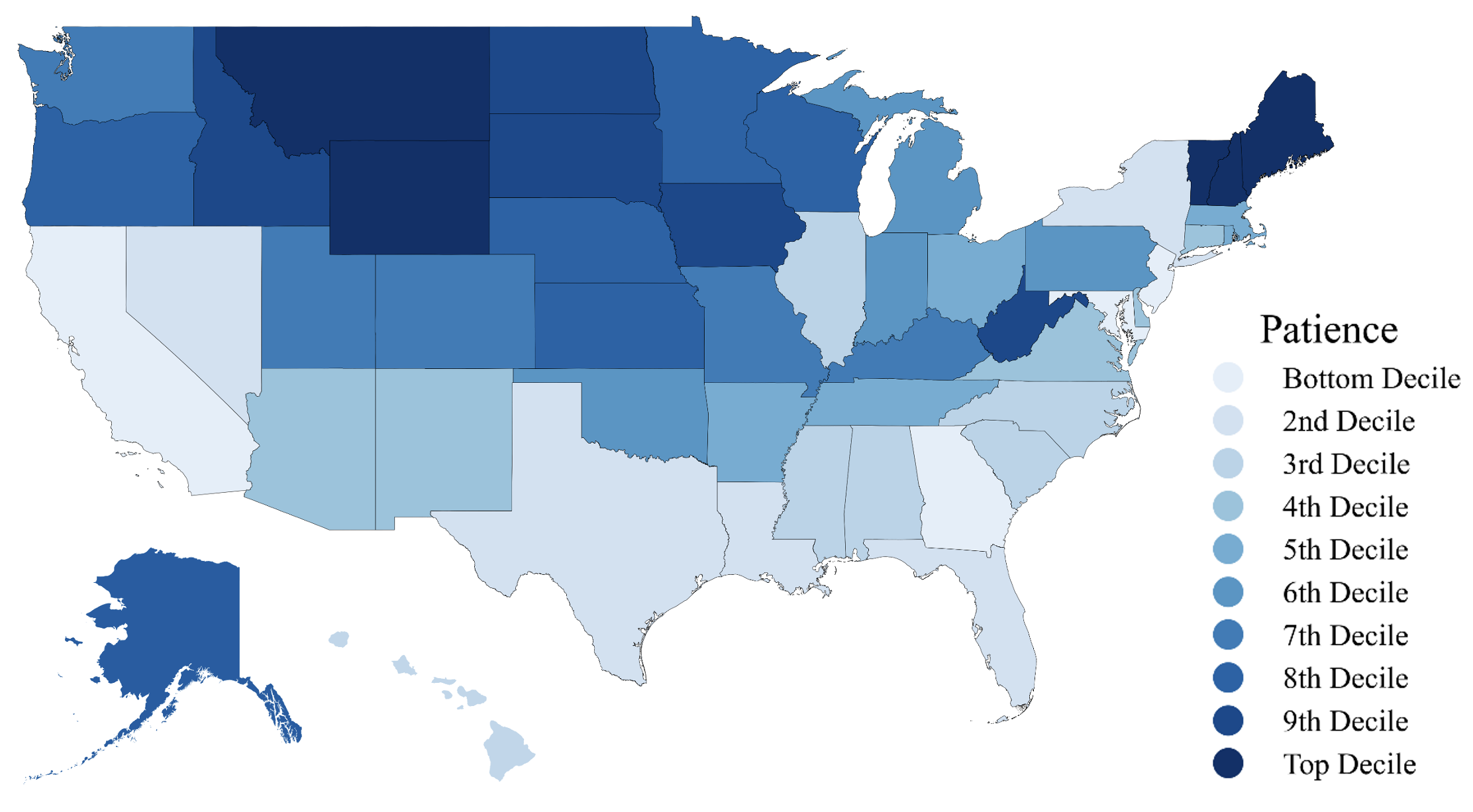Students’ academic achievement varies widely and persistently across regions in many countries. For example, in both Italy and the US, eighth-grade maths achievement differs between the top- and bottom-performing region/state by the equivalent of over two years of learning – roughly two-thirds of the achievement difference between top-performing and bottom-performing OECD countries. Such regional skill differences are very important for regional income differences (Hanushek et al. 2017).
Ever since the publication of Becker’s human capital theory (Becker 1964), discount rates have been recognised as an important determinant of individual decisions to invest in skills (e.g. Sutter et al. 2013, Golsteyn et al. 2014, Castillo et al. 2019, Angerer et al. 2023). But their role at the individual level is just part of the full impact of time preferences. Patience – the relative valuation of present versus future payoffs – appears in many closely related decisions. At the individual level, students weigh current gratification such as play time with friends against study time that may lead to deferred rewards. At the group level, communities trade off present against future costs and benefits when deciding how much to invest in school quality, how strongly to motivate children to learn, and whether to design institutions to incentivise learning. Such effects of aggregate preferences, which are a component of cultural identities, are consistent with the influence of patience found for international achievement differences (Figlio et al. 2019, Hanushek et al. 2020, 2022) and for economic development (Galor and Özak 2016, Sunde et al. 2022).
In new research (Hanushek et al. 2023), we study whether differences in people’s patience can account for the large and longstanding subnational differences in student achievement.
Using Facebook interests to measure patience at the regional level
Subnational investigation of patience has been stymied by a lack of representative, region-specific measures of time preferences. The key methodological innovation of our research is combining the massive data available from social media – specifically, Facebook interests – with machine-learning algorithms to derive new subnational measures of patience. Our derivation of regional patience measures builds on recent international analysis of culture in Obradovich et al. (2022) (see also Rahwan et al. 2020) and contributes to the recent work using social-media data in analysing culture and social networks (e.g. Chetty et al. 2022, Bailey et al. 2022).
The primary idea is that social media data contain important information about people’s underlying preferences. For marketing purposes, Facebook has developed an algorithm to classify the ‘interests’ of more than two billion people based on their self-reported interests, clicks and likes on Facebook, software downloads, clicks on Facebook’s ads on other sites, and additional inferences from overall behaviour and location. The hundreds of thousands of interests classified by Facebook are organised in categories such as business, entertainment, family, wellness, food, hobbies, fashion, sports, and technology. We scrape Facebook’s marketing application programming interface to identify the 1,000 Facebook interests with the largest audiences worldwide.
From these globally relevant interests, we derive measures for national and subnational levels of patience. We extract data on the prevalence of Facebook interests in each country and region, and reduce their dimensionality by principal component analyses. Employing machine-learning techniques, we train an international model to predict the scientifically validated patience measure of the Global Preference Survey (GPS) (Falk et al. 2018, Sunde et al. 2018) from the principal components of the Facebook interests.
We validate the newly derived measure of patience through an international analysis that mimics prior investigations of preferences and cross-country achievement differences (Figlio et al. 2019, Hanushek et al. 2022). Our Facebook-derived measure performs as well as the original GPS measure in predicting PISA student achievement across the 48 GPS countries. Out-of-sample predictions allow us to expand the analysis beyond GPS countries to a total of 80 countries, and the patience measure provides very consistent predictions of PISA achievement for the expanded sample and the 32 added countries.
We use the parameters estimated from international Facebook interests to construct subnational patience measures across 20 regions for Italy, and across 50 states for the US based on observed regional Facebook interests. In Italy, the regions with the lowest patience measure are Sicily and Campania in the South; the highest measure is found in Trentino-Alto-Adige in the Northeast (Figure 1). In the US, the states with the highest level of patience are Vermont and Maine in the Northeast (Figure 2). Both countries show substantial North-South variation in the Facebook-derived measure of patience that coincide with the longstanding geographical disparities in the two countries (for Italy, see e.g. Putnam 1993, Guiso et al. 2004, Bigoni et al. 2018).
Figure 1 Facebook-derived measure of patience for Italian regions
Source: Hanushek et al. (2023).
Figure 2 Facebook-derived measure of patience for US states
Source: Hanushek et al. (2023).
Non-representative regional preference measures from the GPS provide another way of validating the Facebook-derived patience measures. We can use the regional identifiers contained in the GPS data to construct regional GPS measures of patience (Sunde et al. 2022). These are obviously very noisy due to the small regional GPS sample sizes, averaging 50 individuals per Italian region and 20 per US state. Nonetheless, these are significantly positively correlated with our measure at 0.49 across Italian regions and 0.23 across US states.
Patience and student achievement across Italian regions and US states
We employ the newly derived regional measures of patience in analyses of subnational student achievement in Italy (using INVALSI test data) and the US (using NAEP data).
The Facebook-derived measure of patience is strongly associated with regional student achievement in both countries. In Italy, a one standard deviation increase in regional patience is related to a 1.2–1.5 standard deviation increase in eighth-grade maths achievement (Figure 3). This is only slightly smaller than the estimate in the above-mentioned cross-country analysis. In the US, the equivalent estimate is statistically significant, albeit only about one quarter in magnitude (Figure 4).
Figure 3 Patience and student achievement across Italian regions
Source: Hanushek et al. (2023).
Figure 4 Patience and student achievement across US states
Source: Hanushek et al. (2023).
Regional differences in patience account for over two-thirds of the test-score variation across Italian regions and over one-third across US states. The smaller role in the US may reflect the substantial cross-state mobility of the US population, which lessens the preference heterogeneity and alters the intergenerational transmission of cultural traits.
While the regional analysis is descriptive, two aspects speak against major bias. First, our cross-country analysis indicates limited bias when we assign migrant students the patience measure of their origin country. This allows conditioning on fixed effects for residence countries to shield against simple reverse causation and unobserved features of students’ residence countries. Second, the within-country estimation is less prone to confounding from unobserved national traits such as languages, constitutions, and institutional factors – a problem that has hampered prior cross-country analyses.
Consistent with skill development as a cumulative process, the association between patience and student achievement is stronger the higher the student’s grade level. In Italy, estimates grow steadily across the four National Institute for the Evaluation of the Education and Training System (INVALSI) testing occasions from second to tenth grade. Similarly, estimates for the US National Assessment of Educational Progress (NAEP) grow from fourth to eighth grade.
All results account for regional variation in risk-taking, another preference affecting intertemporal decisions. But the machine-learning model that predicts risk-taking from Facebook interests does not perform very well at the regional level. The poor measurement of risk-taking implies that the estimates of patience are at lower bounds because patience and risk-taking are positively associated, and prior work suggests a negative association of risk-taking with student achievement (Hanushek et al. 2022).
Results do not differ significantly by gender, and are robust in the available separate assessment waves. We find similar results for reading achievement in both countries, albeit with slightly smaller point estimates. Moreover, results are consistent for six additional countries where regional achievement data cover fewer grades or regions. The positive association between regional student achievement and Facebook-derived patience holds in a pooled sample of 190 regions in eight countries. The association is separately significant in all additional countries (Brazil, Canada, Germany, Kazakhstan, and Mexico) except Spain.
The importance of patience for longstanding subnational disparities
Regional differences in student achievement are historically large and persistent but poorly understood and understudied. Our analysis shows that subnational differences in Facebook-derived measures of patience provide a powerful explanation of variation in student outcomes across Italian regions and US states. This new perspective on student performance helps to explain why, for example, North-South differences in student outcomes in both countries have been very stable over time even in the face of national efforts to equalise performance.
When concerned about within-country differences in student achievement, policymakers might look beyond proximate factors – such as school spending or even family educational background – and take possible differences in patience into account. Institutional features of schooling such as reliance on parental choice or test-based accountability are less tied to aggregate preferences (Hanushek et al. 2022). Thus, institutional reforms of school systems appear a viable policy mechanism for improvement that does not necessarily depend on changing preferences (Woessmann 2016). Moreover, while cultural traits are considered hard to change (e.g. Guiso et al. 2006, Bisin and Verdier 2011), recent evidence shows that traits such as patience are malleable, especially at a young age, and can be improved through specific interventions (e.g. Bird 2001, Alan and Ertac 2018, Jung et al. 2021). Hence, policies aimed at increasing patience may be an avenue for addressing educational investments and regional deficits in student outcomes.
References
Alan, S and S Ertac (2018), “Fostering Patience in the Classroom: Results from Randomized Educational Intervention”, Journal of Political Economy 126(5): 1865–911.
Angerer, S, J Bolvashenkova, D Glätzle-Rützler, P Lergetporer and M Sutter (2023), “Children’s Patience and School-Track Choices Several Years Later: Linking Experimental and Field Data”, Journal of Public Economics 220: 104837.
Bailey, M, D M Johnston, M Koenen, T Kuchler, D Russel and J Stroebel (2022), “The Social Integration of International Migrants: Evidence from the Networks of Syrians in Germany”, NBER Working Paper 29925.
Becker, G S (1964), Human Capital: A Theoretical and Empirical Analysis, with Special Reference to Education, New York: National Bureau of Economic Research.
Bigoni, M, S Bortolotti, M Casari and D Gambetta (2018), “At the Root of the North-South Cooperation Gap in Italy: Preferences or Beliefs?”, Economic Journal 129(619): 1139–52.
Bird, E J (2001), “Does the Welfare State Induce Risk-Taking?”, Journal of Public Economics 80(3): 357–83.
Bisin, A and T Verdier (2011), “The Economics of Cultural Transmission and Socialization”, Handbook of Social Economics, Amsterdam: 339–416.
Castillo, M, J L Jordan and R Petrie (2019), “Discount Rates of Children and High School Graduation”, Economic Journal 129(619): 1153–81.
Chetty, R, M O Jackson, T Kuchler, J Stroebel and N Hendren et al. (2022), “Social Capital I: Measurement and Associations with Economic Mobility”, Nature 608(7921): 108–21.
Falk, A, A Becker, T Dohmen, B Enke, D Huffman and U Sunde (2018), “Global Evidence on Economic Preferences”, Quarterly Journal of Economics 133(4): 1645–92.
Figlio, D, P Giuliano, U Özek and P Sapienza (2019), “Long-Term Orientation and Educational Performance”, American Economic Journal: Economic Policy 11(4): 272–309.
Galor, O and Ö Özak (2016), “The Agricultural Origins of Time Preference”, American Economic Review 106(10): 3064–103.
Golsteyn, B H H, H Grönqvist and L Lindahl (2014), “Adolescent Time Preferences Predict Lifetime Outcomes”, Economic Journal 124(580): F739–F761.
Guiso, L, P Sapienza and L Zingales (2004), “The Role of Social Capital in Financial Development”, American Economic Review 94(3): 526–56.
Guiso, L, P Sapienza and L Zingales (2006), “Does Culture Affect Economic Outcomes?”, Journal of Economic Perspectives 20(2): 23–48.
Hanushek, E A, J Ruhose and L Woessmann (2017), “Knowledge Capital and Aggregate Income Differences: Development Accounting for U.S. States”, American Economic Journal: Macroeconomics 9(4): 184–224.
Hanushek, E A, L Kinne, P Lergetporer and L Woessmann (2020), “Patience, Risk-taking, and International Differences in Student Achievement”, VoxEU.org, 2 August.
Hanushek, E A, L Kinne, P Lergetporer and L Woessmann (2022), “Patience, Risk-Taking, and Human Capital Investment across Countries”, Economic Journal 132(646): 2290–307.
Hanushek, E A, L Kinne, P Sancassani and L Woessmann (2023), “Can Patience Account for Subnational Differences in Student Achievement? Regional Analysis with Facebook Interests”, NBER Working Paper 31690.
Jung, D, T Bharati and S Chin (2021), “Does Education Affect Time Preference? Evidence from Indonesia”, Economic Development and Cultural Change 69(4): 1451–99.
Obradovich, N, Ö Özak, I Martín, I Ortuño-Ortín, E Awad, M Cebrián, R Cuevas, K Desmet, I Rahwan and Á Cuevas (2022), “Expanding the Measurement of Culture with a Sample of Two Billion Humans”, Journal of The Royal Society Interface 19(190): 20220085.
Putnam, R D (1993), Making Democracy Work: Civic Traditions in Modern Italy, Princeton University Press.
Rahwan, I, I Ortuño-Ortin, Ö Özak, I Martín, N Obradovich and K Desmet et al. (2020), “The Enormous Potential of Social Media to Measure Human Culture”, VoxEU.org, 31 October.
Sunde, U, D Huffman, A Falk, B Enke, T Dohmen and A Becker (2018), “Variation in Economic preferences around the World with Implications for Understanding Inequality: Evidence from the Global Preferences Survey”, VoxEU.org, 19 June.
Sunde, U, T Dohmen, B Enke, A Falk, D Huffman and G Meyerheim (2022), “Patience and Comparative Development”, Review of Economic Studies 89(5): 2806–40.
Sutter, M, M G Kocher, D Glätzle-Rützler and S T Trautmann (2013), “Impatience and Uncertainty: Experimental Decisions Predict Adolescents’ Field Behavior”, American Economic Review 103(1): 510–31.
Woessmann, L (2016), “The Importance of School Systems: Evidence from International Differences in Student Achievement”, Journal of Economic Perspectives 30(3): 3–32.











